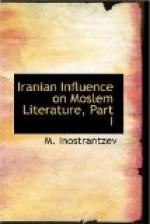* * * * *
It is, above all, Arabic literature which upsets the easy fiction of total destruction of Iranian culture by the Arabs. In its various departments of history, geography and general science Arabic works incorporate extensive material for a history of Iranian civilization, while Arabic poetry abounds in references to Zoroastrian Iran. The former is illustrated by Professor Inostranzev’s pioneer Russian essay of which the main body of this book is a translation. The Appendices are intended to be supplementary and to be at once a continuation and a possible key—continuation of the researches of the Russian scholar and key to the contemned store-house of Arabic letters.
Professor Inostranzev is in little need of introduction to English scholars. He has already been made known in India by the indefatigable Shams-ul-Ulma Dr. Jivanji Modi, Ph.D., C.I.E., who got translated, and commented on, his Russian paper on the curious Astodans or receptacles for human bones discovered in the Persian Gulf region. He shares with Professor Browne of Cambridge and the great M. Blochet a unique scholarly position: he combines an intimate knowledge of Avesta civilization with a familiarity with classical Arabic. It is not wilfully to ignore the claims of Goldziher, Brockelmann or Sachau or the Dutch savants de Goeje and Van Vloten. Deeply as they investigated Arabic writings, it was M. Inostranzev who first revealed to us the worth of Arabic: he unearthed chapters embedded in Arabic books which are paraphrase or translation of Pahlavi originals. He had but one predecessor and that was a countryman of his, Baron Rosen.
* * * * *




